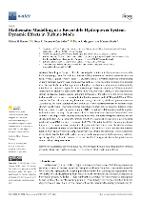Mathematic Modelling of a Reversible Hydropower System: Dynamic Effects in Turbine Mode
Fecha
2023Autor(es)
Ramos, Helena M.
Coronado-Hernández, Oscar E.
Morgado, Pedro A.
Simão, Mariana
Metadatos
Mostrar el registro completo del ítemResumen
Over the past few years, there has been significant interest in the importance of reversible hydro-pumping systems due to their favorable flexibility and economic and environmental characteristics. When designing reversible lines, it is crucial to consider dynamic effects and corresponding extreme pressures that may occur during normal and emergency operating scenarios. This research describes essentially the turbine operation, although various boundary elements are mathematically formulated and presented to provide an understanding of the system complexity. Different numerical approaches are presented, based on the 1D method of characteristics (MOC) for the long hydraulic circuit, the dynamic turbine runner simulation technique for the behavior of the power station in turbine mode and the interaction with the fluid in the penstock, and a CFD model (2D and 3D) to analyze the flow behavior crossing the runner through the velocity fields and pressure contours. Additionally, the simulation results have been validated by experimental tests on different setups characterized by long conveyance systems, consisting of a small scale of pumps as turbines (at IST laboratory) and classical reaction turbines (at LNEC laboratory). Mathematical models, together with an intensive campaign of experiments, allow for the estimation of dynamic effects related to the extreme transient pressures, the fluid-structure interaction with rotational speed variation, and the change in the flow. In some cases, the runaway conditions can cause an overspeed of 2–2.5 of the rated rotational speed (NR) and an overpressure of 40–65% of the rated head (HR), showing significant impacts on the pressure wave propagation along the entire hydraulic circuit. Sensitivity analyses based on systematic numerical simulations of PATs (radial and axial types) and reaction turbines (Francis and Kaplan types) and comparisons with experiments are discussed. These evaluations demonstrate that the full-load rejection scenario can be dangerous for turbomachinery with low specific-speed (ns) values, in particular when associated with long penstocks and fast guide vane (or control valve) closing maneuver. © 2023 by the authors.
Citar como
Ramos, H. M., Coronado-Hernández, O. E., Morgado, P. A., & Simão, M. (2023). Mathematic Modelling of a Reversible Hydropower System: Dynamic Effects in Turbine Mode. Water, 15(11), 2034.Utilice esta dirección para citar:
https://hdl.handle.net/20.500.12585/12385Colecciones
- Productos de investigación [1453]
Compatible para recolección con:

Archivos
El ítem tiene asociados los siguientes ficheros de licencia:
Universidad Tecnológica de Bolívar - 2017 Institución de Educación Superior sujeta a inspección y vigilancia por el Ministerio de Educación Nacional. Resolución No 961 del 26 de octubre de 1970 a través de la cual la Gobernación de Bolívar otorga la Personería Jurídica a la Universidad Tecnológica de Bolívar.













